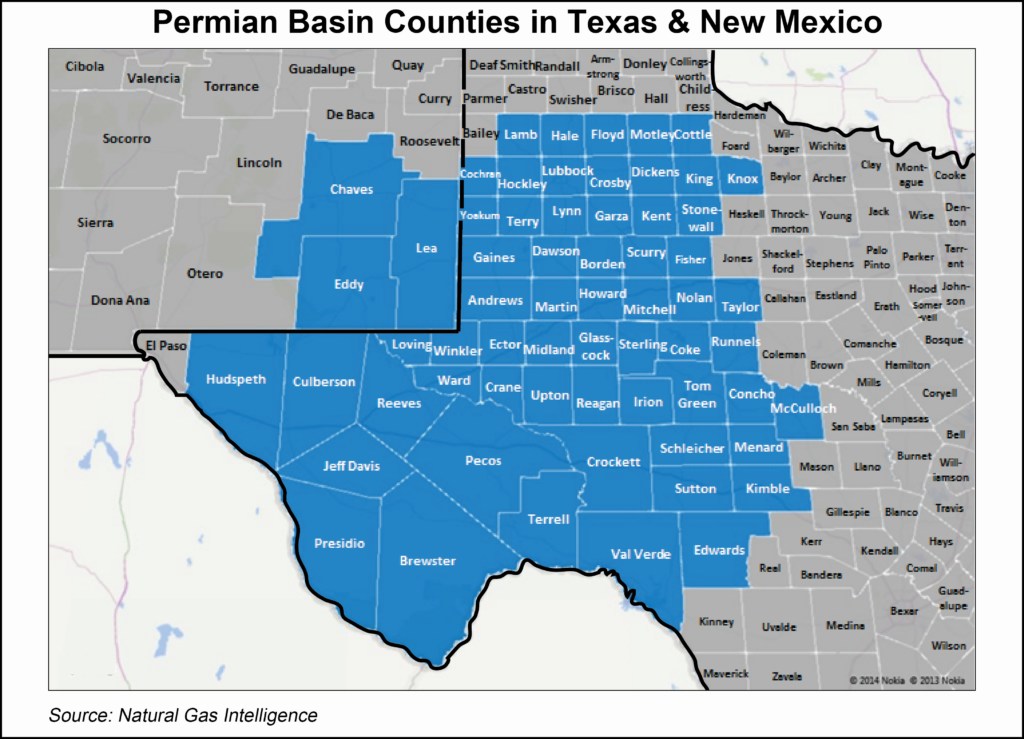Shale Daily | E&P | NGI All News Access | NGI The Weekly Gas Market Report
Permian Methane Emissions Estimated at Three Times Nationwide Rate
New measurements by atmospheric scientists in the most productive part of the Permian Basin indicate methane is escaping from oil and natural gas wells at around three times the nationwide rate.

The scientists, using the Environmental Defense Fund (EDF) PermianMAP initiative, detected a 3.5% loss rate in a study area, roughly 15 times higher than targets set by some of the region’s leading exploration and production (E&P) operators and higher than many have reported.
The rate detected represents an estimated loss of 1.4 million metric tons/year of natural gas, the nonprofit said.
“Oil and gas companies have a core responsibility to protect health, safety and the environment,” said EDF’s Matt Watson, vice president for Energy. “This data shows that operators in the Permian are failing to meet that basic obligation. As company staffing and state oversight are stretched thin, it’s all the more crucial to maintain close watch on these emissions so leaks don’t go unnoticed or unrepaired.”
Data was collected from last October through March across a 6,200 square-mile study area that EDF said is responsible for 40% of the Permian’s production. Tower-based monitors, ground-
based mobile sensors, fixed-wing aircraft and helicopters were used to capture the data.
Some wells were found to be releasing methane “through leaks, venting and malfunctioning flares at more than 100 times the national average rate,” EDF noted.
The PermianMAP findings are the first from the year-long project launched last October to help
regulators and operators reduce methane emissions and provide data to help inform developing policies to tackle the ongoing methane problem.
“Our goal is to protect communities, help companies improve field practices and make sure the
public knows what’s happening and can engage on critical policy questions,” Watson said. “As
we collect more data and are able to draw comparisons in the performance of individual
operators, we anticipate this information will also be helpful to investors, who are increasingly
focused on what companies are doing to reduce emissions.”
New Mexico has embarked on a process to adopt methane rules by the end of the year, with a goal to reduce greenhouse gas emissions in 2030 by 45%. Regulators at the Railroad Commission of Texas have come under scrutiny for allowing gas to be flared from oil wells. The commission has not denied any of the more than 27,000 requests for flaring permits submitted over the past seven years, EDF noted.
New data from EDF is to be made available on a periodic basis as researchers continue to measure emissions over the course of the year. However, EDF noted that in recent weeks, researchers have been operating under strict protocols to protect against the coronavirus and plan to continue to operate under guidelines, which could include suspending operations as necessary.
In December the Energy Information Administration said the volume of domestic gas vented and flared in 2018 reached a record high average of 1.28 Bcf/d, with Texas and North Dakota accounting for 82%.
Meanwhile, gas flaring levels in the Permian are expected to decline through the rest of the year and be near 2012 levels, according to a recent analysis by Rystad Energy. The preliminary estimate for levels in 1Q2020 was 700 MMcf/d, with around 550 MMcf/d flared at the wellhead, the lowest quarterly rate since 3Q2018.
“The basin-wide wellhead flaring ratio fell below 3.5% in the first quarter of 2020, and additional improvements are expected to materialize throughout the remainder of 2020,” said Rystad’s Artem Abramov, head of shale research. “This is especially true now, in this period of collapsing basin-wide completion activity amid an oil price crash and prolonged price weakness.”
© 2024 Natural Gas Intelligence. All rights reserved.
ISSN © 2577-9877 | ISSN © 1532-1266 | ISSN © 2158-8023 |
